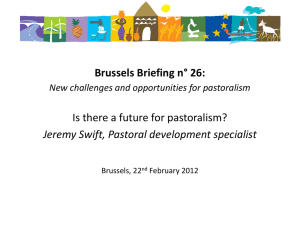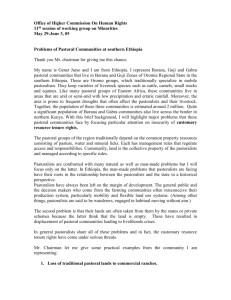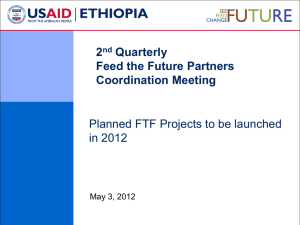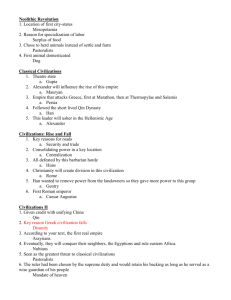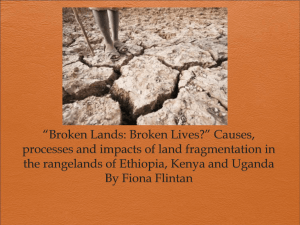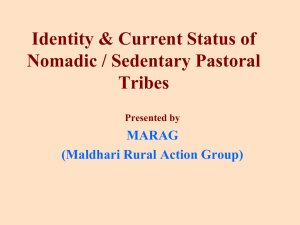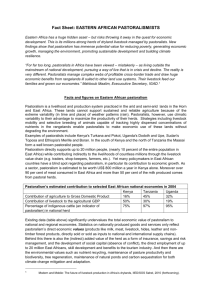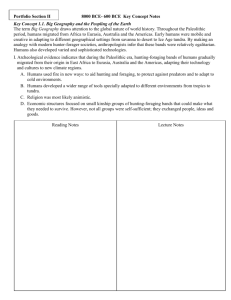Emerging responses to climate change in pastoral
advertisement
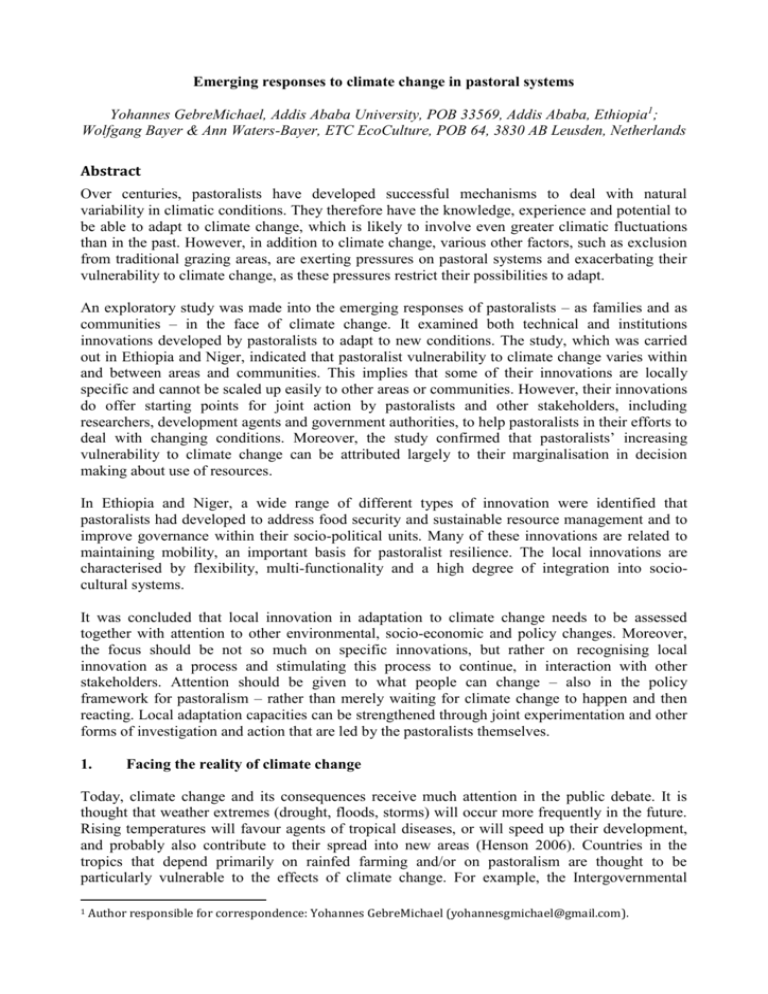
Emerging responses to climate change in pastoral systems Yohannes GebreMichael, Addis Ababa University, POB 33569, Addis Ababa, Ethiopia1; Wolfgang Bayer & Ann Waters-Bayer, ETC EcoCulture, POB 64, 3830 AB Leusden, Netherlands Abstract Over centuries, pastoralists have developed successful mechanisms to deal with natural variability in climatic conditions. They therefore have the knowledge, experience and potential to be able to adapt to climate change, which is likely to involve even greater climatic fluctuations than in the past. However, in addition to climate change, various other factors, such as exclusion from traditional grazing areas, are exerting pressures on pastoral systems and exacerbating their vulnerability to climate change, as these pressures restrict their possibilities to adapt. An exploratory study was made into the emerging responses of pastoralists – as families and as communities – in the face of climate change. It examined both technical and institutions innovations developed by pastoralists to adapt to new conditions. The study, which was carried out in Ethiopia and Niger, indicated that pastoralist vulnerability to climate change varies within and between areas and communities. This implies that some of their innovations are locally specific and cannot be scaled up easily to other areas or communities. However, their innovations do offer starting points for joint action by pastoralists and other stakeholders, including researchers, development agents and government authorities, to help pastoralists in their efforts to deal with changing conditions. Moreover, the study confirmed that pastoralists’ increasing vulnerability to climate change can be attributed largely to their marginalisation in decision making about use of resources. In Ethiopia and Niger, a wide range of different types of innovation were identified that pastoralists had developed to address food security and sustainable resource management and to improve governance within their socio-political units. Many of these innovations are related to maintaining mobility, an important basis for pastoralist resilience. The local innovations are characterised by flexibility, multi-functionality and a high degree of integration into sociocultural systems. It was concluded that local innovation in adaptation to climate change needs to be assessed together with attention to other environmental, socio-economic and policy changes. Moreover, the focus should be not so much on specific innovations, but rather on recognising local innovation as a process and stimulating this process to continue, in interaction with other stakeholders. Attention should be given to what people can change – also in the policy framework for pastoralism – rather than merely waiting for climate change to happen and then reacting. Local adaptation capacities can be strengthened through joint experimentation and other forms of investigation and action that are led by the pastoralists themselves. 1. Facing the reality of climate change Today, climate change and its consequences receive much attention in the public debate. It is thought that weather extremes (drought, floods, storms) will occur more frequently in the future. Rising temperatures will favour agents of tropical diseases, or will speed up their development, and probably also contribute to their spread into new areas (Henson 2006). Countries in the tropics that depend primarily on rainfed farming and/or on pastoralism are thought to be particularly vulnerable to the effects of climate change. For example, the Intergovernmental 1 Author responsible for correspondence: Yohannes GebreMichael (yohannesgmichael@gmail.com). Yohannes GM et al: Emerging responses to climate change in pastoral systems Panel on Climate Change (IPCC 2007) predicted that, in some of these countries, agricultural production could decline by as much as 50% by 2020. Similarly, UNEP (2006) has estimated that, by 2025, about 480 million people in Africa could be living in water-stressed areas. It has also been predicted that, with growing climatic uncertainty, many African crop farmers will increasingly diversify their agricultural activities and will engage more in livestock-keeping (Spore 2008, Rodriguez 2008). In other words, agro-pastoral and pastoral systems may become more important in the future, as the climate changes. 2. Living with climatic variability Climatic variability is not a new phenomenon in Ethiopia. For example, from 1540 to 1800 AD, 26 major droughts and famines were recorded and the “great Ethiopian famine” happened in the period 1889–92 (McKee 2008, Pankhurst 1985). Famines are caused not only by droughts; also excessive and prolonged rainfall can lead to harvest failures and famines. Furthermore, epidemics and political crises can cause famines. Because Ethiopian pastoralists have a long history of exposure to climatic variability, they have – out of necessity – developed mechanisms to cope with it. This holds true not only for Ethiopia, but also for many other countries in Africa and elsewhere in the world where pastoralists have survived for centuries. The mechanisms used by pastoralists to cope with high climatic variability include moving their livestock and families, keeping different animal species (and, within species, sometimes different types of animals), making reciprocal arrangements with other pastoralist groups for access to pasture and water, developing water-conservation techniques, observing early-warning signs of impending drought and practising complementary livelihood activities (e.g. trade or, where possible, cultivation). Such adaptations and practices were developed long before the concept of “climate change” became known (McKee 2008). 3. Pastoralists’ adaptation to climatic variability Pastoralists are people who depend for their living primarily on livestock that graze natural pasture. There are no reliable data on the total number of people whose livelihoods depend on pastoralism; estimates vary greatly, partly because the definition of pastoralists varies from country to country. The Secretariat of the Convention on Biological Diversity (2010) gives the very broad estimate that between 100 and 200 million people throughout the world depend on pastoralism. Estimates of the number of pastoralists and agro-pastoralists on the African continent vary between 20 and 40 million. In Ethiopia, where pastoral lowlands cover about 60% of the country, 12–15 million people are thought to live in these areas (MoFED 2006). However, not all of them are true pastoralists, i.e. some of them no longer have any livestock so cannot be said to live from pastoralism, but they are still considered to be “pastoralists” in ethnic terms. Pastoral areas are usually arid and semiarid lands with low and erratic rainfall that also varies in terms of space and time. Thus, uncertainty and risk are the rule, not the exception. This variability requires flexibility in resource use (grasping opportunities and coping with shortages) and a high degree of adaptability to constantly changing conditions. Mobility is one of the most successful strategies used by most pastoralist groups to deal with uncertainty and risk. By maintaining a high degree of mobility, they can take their animals to “follow the rains” and thus the availability of forage. Mobility also allows them to avoid pests (e.g. ticks) and diseases that arise when conditions become wetter. It may serve as a means to avoid conflict with other groups using the same resources for part of the year. It may also reduce the risk of becoming a victim of livestock raiding. In addition, mobility helps in conserving CCAA May 2010 Keynote Paper 2 Yohannes GM et al: Emerging responses to climate change in pastoral systems biodiversity. In many dry areas, pastoralist groups have a long history of mobility. In more recent times, many pastoralists have grasped the opportunities of new communication technology and are using mobile phones to help them manage mobility (e.g. finding out about conditions in other areas) and also to have easier and quicker access to market information (Scoones 1995, Hesse & MacGregor 2006, Scoones & Adwera 2009, Yohannes & Mebratu 2009). Good management of mobility requires considerable logistical and organisational skills. Some of the questions that need to be answered when moving with livestock are: • What are the conditions in the target area (i.e. where the pastoralists want to move to) with respect to forage, water and animal disease? • What is the security situation along the way and in the target area? Is it safe to move as a small group, or is a larger group required? If so, with whom to move? • How far must the animals be trekked? If the distance between the present and the foreseen future grazing ground is more than about 20 km, an overnight stop is required and provisions for watering animals may be necessary; for longer distances covering several days or weeks, knowledge of the grazing conditions along the way is also important. • What negotiations will be needed and who will do them? If the herds need to travel across land that is owned (or used) by other groups or by private individuals, rights of passage need to be negotiated. If the pastoralists are travelling along well-established (traditional) stock routes, there may be secondary or even tertiary land-use rights by other ethnic groups and traditional cordial relationships between them, but these relationships need to be maintained. • What are the legal requirements? In many countries – and increasingly so – permits to move livestock from one area to another, especially across regional or state boundaries, may be required, and these permits must be obtained from the relevant authorities. Pastoralists often keep different animal species and categories as a strategy to reduce risk, to improve productivity, to reduce environmental impacts, to facilitate marketing and to exploit a wider range of ecological niches, using both grazing and browsing animals. Keeping a range of livestock species also reinforces the multi-functionality of livestock. Small ruminants may be useful for frequent sales and for providing appropriate amounts of meat to be eaten by a family, whereas larger species, such as cattle or camels, may be sold when larger amounts of money are needed and may be kept for milk production. Camels and donkeys are also useful for transport. Furthermore, pastoralist groups may attach cultural importance to certain types of livestock, e.g. for bride wealth. Camels and goats are usually more drought-resistant than cattle and sheep, but the latter may do better in a year that is wetter than usual. When drought occurs, as happens frequently but irregularly in arid and semiarid areas, pastoralists have to master a “drought cycle”, which may include moving livestock to sites they do not often use but where forage is better at that particular time, selling male animals when prices are still good, drying off cows and foregoing calf production, trying to keep the breeding herd intact etc. Droughts and their severity are hard to predict and drought-cycle management always has an element of speculation, as nobody knows in advance when the rains will recommence. Normally, selling animals during a drought brings in only very low prices whereas, after a drought breaks and rain sets in again, livestock prices rise (e.g. Toulmin 1994). For pastoralists, it is always a gamble. The vegetation in pastoral areas is also useful for multiple purposes, which also helps in dealing with climatic variations. Certain areas may be important for rituals. The vegetation may also be used for ethno-(veterinary) medicine, beekeeping, gathering wild foods, or collecting firewood for use at home or for sale. The state of the vegetation may serve as an early-warning indicator of drought. Moreover, traditional seasonal farming along riverbanks (e.g. (flood-retreat cropping in CCAA May 2010 Keynote Paper 3 Yohannes GM et al: Emerging responses to climate change in pastoral systems the Southern Region of Ethiopia) is often done with planting sticks, a traditional way of doing zero tillage (Yohannes 2002, Taffese 2005, Zartman 2000); thus, also this sustainable farming practice can also be part of the traditional land-use system in seasonally dry areas used by pastoralists. Traditionally, in times of low external pressures, pastoralist groups were quite successful in regulating the diverse uses of livestock and vegetation and in resolving the inevitable conflicts when different groups (seek to) use the same natural resources. In general, flexibility, dynamism, multi-functionality, complementarity and reciprocity in resource use are attributes of viable pastoral production systems. 4. The paradox: productive and adaptable yet vulnerable pastoralists Studies over the last 30 years or so have shown that traditional pastoral systems are relatively productive and represent an ecologically sustainable way of using arid and semi-arid lands. There are indications from a number of African countries (Botswana, Ethiopia, Mali, Mozambique, South Africa, Tanzania, Uganda, Zimbabwe) that traditional pastoral systems can produce up to ten times more food per unit area than can modern ranching (Scoones 1995). This is due to a large extent to the multiple uses of resources and the multiple functions of livestock in traditional pastoral systems. The Ministry of Agriculture and Rural Development (MoARD 2005) estimates that, in Ethiopia, pastoralists keep about three-quarters of all goats in the country, one quarter of the sheep, 20% of the cattle and all of the camels. The livestock sector ranks second after coffee in generating foreign exchange for Ethiopia (IIED & SOS Sahel 2010). Pastoral areas not only meet most of the domestic meat demand but are also the main suppliers of livestock for export, generating about US$ 50 million per annum for Ethiopia (Yakob & Catley 2010). Indeed, the actual figures will be even higher, as substantial cross-border trade takes place which escapes official statistics. Yet many policymakers in Ethiopia and also in other countries still think that sedentarisation of pastoralists is the best way forward, and that mobile pastoralism is backward and primitive and a cause for poverty and land degradation. Policymakers in Ethiopia generally have a poor understanding of the rationale and productivity of pastoralism. In order to solve what they regard as the “problem” of pastoralism, they seek to “modernise” agriculture by settling the pastoralists and expanding irrigation schemes along rivers in the drylands. The big move towards large-scale biofuel plantations in Ethiopia is making the situation even worse.2 If the best grazing land is taken up by irrigated agriculture, with labourers brought in from elsewhere, this does little to improve the livelihoods of (former) pastoralists. But land-use planners continue to allocate prime grazing land and water resources to state farms, private investors and national parks for wildlife conservation. As a result, pastoralists have little or no access to pasture and water during the dry season and during prolonged drought periods. This could ultimately destroy the entire pastoralist system and mean that the other dryland areas used by pastoralists at other times of the year (and not suitable for alternative uses) will no longer be productive and can support far fewer people’s livelihoods. As already outlined above, over centuries, pastoralists have developed successful mechanisms to deal with natural variability in climatic conditions. They therefore have the knowledge, experience and potential to be able to adapt to climate change. However, other factors such as exclusion from traditional grazing areas are creating pressures on the pastoral systems and are 2 The devastating effects on people and biodiversity exerted by biofuel plantations set up on marginal and supposedly “idle” land have been documented and reported, among others, by Bailey (2008) and Mutch (2010). CCAA May 2010 Keynote Paper 4 Yohannes GM et al: Emerging responses to climate change in pastoral systems increasing their vulnerability to climate change, as they restrict pastoralists’ possibilities to adapt. This is pointed out by Devereux (2006) based on his research among Somali pastoralists in Ethiopia: it is not meteorological drought that makes the pastoralists more vulnerable; rather, it is the increasing marginalisation of their drought-response mechanisms. This marginalisation is brought about by restrictions on mobility of animals and people (which may also lead to intensification of conflict), stricter control over cross-border trade (so-called “contraband”), a land-tenure policy that disadvantages pastoralists, lack of political power among pastoralists, and land-use planners’ and administrators’ disregard of indigenous knowledge, skills and customary institutions of land-use management (Yohannes & Waters-Bayer 2002, Mebratu 2009). 5. Causes of pastoralists’ vulnerability to climate change Pastoralist communities and their environment differ a great deal from place to place. The emerging responses to climatic variability and to climate change will therefore be specific to particular groups and sites and cannot be replicated and scaled up easily. However, discussions by the authors with different Ethiopian pastoralists over several years suggest that their vulnerability to climate change depends on some of the following aspects: • Change in responsibility for herd management: When pastoral communities are under pressure and young men seek work elsewhere in order to diversify family income, it is the older men, women and children who have to assume the responsibility for herd management. Because of the lack of strong manpower for heavy tasks, such as watering livestock, or for scouting out areas before moving the herds, these “new” herd managers are more vulnerable to the effects of climate change than young men would be. • Relative herd size. Pastoralist households with small herds or with no livestock at all (these are often female-headed households) are more vulnerable than are households with larger herds; the latter are more likely to be able to survive disasters with at least some livestock and/or can avert risk by selling some stock and restocking later. • Livestock species kept. Camels and goats are generally regarded as more drought-resistant than cattle and sheep but, in wetter (e.g. semi-arid to sub-humid) areas, cattle may fare better, because camels in these areas are more susceptible to disease. Thus, vulnerability will depend on the direction of climate change towards greater aridity or greater humidity. • Strength of customary socio-political institutions. Pastoralist families associated with strong clans and subclans are less vulnerable than are those associated with weaker ones, as the internal “safety net” is usually more intact. Minority ethnic groups living in pastoral areas but engaged primarily in fishing, beekeeping or hunting may be particularly vulnerable to climate change compounded by other pressures on their livelihoods. • Geographical location of resource exploitation. Pastoralists who have been pushed out of their traditional grazing areas and forced to live in flood-prone areas become more vulnerable, if they cannot move to higher land during times which the risk of flooding is high. Similarly, people living close to lines of conflict between hostile groups are more vulnerable than those living further away. • Land-use systems. Pastoralists who are obliged to become agro-pastoralists because they have too few animals to live from but do not have the necessary crop-farming skills may become more vulnerable. Many dropouts from pastoral livestock-keeping who take up smallscale irrigation are subsidised by relatives still practising mobile pastoralism. Some of the people taking up small-scale irrigation regard such new occupations as only temporary, and have the aim at re-entering pastoralism; they therefore invest their income from crop farming into livestock in an attempt to regain some degree of resilience (Yohannes & Mebratu 2009). When expressing their own perception of their vulnerability to climate change, pastoralists put particular emphasis on the degree of good governance within traditional socio-political CCAA May 2010 Keynote Paper 5 Yohannes GM et al: Emerging responses to climate change in pastoral systems institutions and on the land policies of the government, in addition to environmental factors such as drought and floods and associated risks of livestock and human disease. 7. Innovation by pastoralists in adaptation to climate change 7.1 Climate-change study by network on promoting local innovation: PROLINNOVA In agricultural development, there is growing evidence (e.g. Reij & Waters-Bayer 2001, WatersBayer et al 2009) of how local adaptation capacities can be supported by building on the knowledge, interest and innovativeness of local actors. Sometimes referred to as Participatory Innovation Development (PID), this approach brings local people together with external actors, such as researchers and non-governmental organisations (NGOs) and can help accelerate the process of innovation, if these external actors take up a facilitative (rather than a leading) role and leave the local land-users in the “driver’s seat”. PROLINNOVA (PROmoting Local INNOVAtion in ecologically oriented agriculture and natural resource management; www.prolinnova.net) is a global learning network that was initiated by NGOs but includes multiple stakeholders. It focuses on recognising the dynamics of local knowledge and enhancing capacities of farmers (including forest dwellers, pastoralists and fisherfolk) to adjust to change – to develop their own site-appropriate systems and institutions of resource management so as to gain food security, sustain their livelihoods and safeguard the environment. The essence of sustainability lies in the capacity to adapt. PROLINNOVA promotes and scales up farmer- or pastoralist-led approaches to development that start with discovering how land-users do informal experiments to develop, adapt and test new ideas for better use of natural resources. Understanding the rationale behind local innovation transforms how research and extension agents view local people. This experience stimulates interest on both sides to enter into joint action. Local ideas are further developed in a participatory process that integrates local knowledge and scientific knowledge: joint action and analysis lead to mutual learning. The term “innovation” broadly refers to the discovery of new and better ways of doing things or modifying an existing way of doing things. It encompasses both incremental and radical changes in thinking, products, processes and/or organisation (Scoones & Adwera 2009). PROLINNOVA (2009) makes the following distinction: • • Local innovation = process of developing new and better ways of doing things Local innovations = the new ways of doing things (in terms of technology or socio-economic organisation or institutional configuration) that result from the innovation process, The PROLINNOVA network includes about 200 NGOs, governmental research and extension organisations, policymakers, educational institutions and land-user organisations from 18 countries, most of them in Africa. Each country programme, coordinated often by an NGO, has developed its own set of activities within the common goal of mainstreaming a participatory approach to innovation development (“PID”). Over the past years, network members have studied numerous cases of local innovation, encouraged researchers and development agents to support these initiatives and documented the experiences for use in policy dialogue. In 2007, the network members began to ask themselves: How relevant is the PID approach for supporting local climate-change adaptation? Can interventions to support adaptation to climate change build on local people’s innovativeness? Do farmers already try to innovate, i.e. to find new ways to cope with the challenges posed by the changing climate and – if possible – even take CCAA May 2010 Keynote Paper 6 Yohannes GM et al: Emerging responses to climate change in pastoral systems advantage of them? What is the wider potential of the link between local innovation to adapt to climate change, on the one hand, to policymaking related to climate change, on the other? To start looking for answers to these questions, PROLINNOVA initiated an exploratory study with funds made available by the Netherlands Directorate General for International Cooperation (DGIS). In 2008, some PROLINNOVA partners in Ethiopia, Nepal and Niger started to conduct studies into local innovation in the face of climate change, with the overall objective of exploring the relevance of local adaptation and innovation and the PID approach to climate-change adaptation at the local level. More specifically, the studies tried to: • Systematically document local experimentation processes which come about as a response to a felt need by local people to adapt to climate change; • Understand local communities’ perceptions of "climate change"; • Stimulate documentation of innovation (processes) at the local level; • Draw lessons on the potential impact/influence of local innovation processes on climatechange adaptation policies and programmes. In Ethiopia, the study was coordinated by the Pastoralist Forum Ethiopia (PFE), a local umbrella NGO which brings together local and international NGOs dealing with pastoral development in the country, in close collaboration with the Geography Department of Addis Ababa University. The study was carried out in Gashamo District in Somali Region, Awash Fentale District in Afar Region and Dasanach District in South Omo Zone in the Southern Region. It focused specifically on innovation by pastoralists in the face of climate change. In Niger, the study was coordinated by the Regional Centre for Agricultural Education (CRESA), a body of the Faculty of Agronomy of the University of Niamey, and was implemented jointly with the National Institute for Agronomic Research (INRAN), two NGOs and the Directorate of Agricultural Development in Maradi Region. The study was carried out in Tahoua, Illéla, Keita and Abalack Districts in Tahoua Region and in Guidan Roumdji, Dakoro and Madarounfa District in Maradi Region. It looked at local innovation in both mixed (crop-livestock) farming and agro-pastoralism. The results of the initial study in Ethiopia were published by Yohannes and Mebratu (2009) and those of the initial study in Niger by Magagi et al (2010). 7.2 Pastoralists’ emerging responses to climate change In Ethiopia and Niger, some examples of pastoralists’ emerging responses to what they perceived as climate change were: • Developing their own cut-and-carry feeding system: Already several decades ago, the Awash National Park in Afar Region of Ethiopia took over large areas of prime grazing land and water points formerly used by Afar pastoralists. These people have gained no benefit from the income from tourism, and their herds have no official access to the park during dry seasons and droughts. Therefore, frequent violent conflicts between Afar pastoralists and park (State) authorities have taken place. Recently, however, some Afar pastoralists have developed their own cut-and-carry system of collecting forage from the park and transporting the forage on the head or in carts drawn by horses or donkeys. This innovation includes collective action by community groups that rent carts jointly, using money contributed by group members, and then distribute the forage within the community. This innovative way of managing forage resources has several benefits: 1) it reduces conflict between the pastoralist community and the State; 2) the cut-and-carry system reduces the risk of disease transmission between livestock and wildlife; 3) the pastoralist community has come to regard the park as a reserve pasture area; and 4) the community has develop a collective financial management mechanism that could serve as a basis also for other economic activities. CCAA May 2010 Keynote Paper 7 Yohannes GM et al: Emerging responses to climate change in pastoral systems • Settlement around waterpoints: In some parts of Somali Region of Ethiopia, man-made water sources in the form of below-ground cisterns (“birkas”) are increasing in number and are often privately owned. Many pastoralists have to sell some of their animals to be able to pay for water, which becomes very expensive during drought. However – sometimes with the help of NGOs and government agencies and sometimes on their own initiative – some pastoralist communities have developed communal sources of water (by harvesting run-off water, digging deep wells or establishing community birkas). This has encouraged some pastoralists to settle at least part of their family – often the women and children – close to the water sources, to have free access to water and short travelling distances for the animals kept near the homes, while other segments of the herd are still moved temporarily to more distant grazing. It remains to be seen whether settlement around waterpoints is an innovation in the sense of a better way of doing things, as problems with water pollution and degradation of land around the waterpoints may arise over time. • Purchasing with credit: During periods of scarcity, some pastoralists have started buying different commodities on a credit basis from small shops (often set up by pastoralists) in the settlements and small towns in the pastoral areas. This mutual relationship between people in the urban and rural areas serves as a new form of safety net in the face of high risks. • Changing herd composition: Because of problems with water, pasture and recurrent drought, pastoralists in both Niger and Ethiopia are increasingly replacing cattle with sheep, goats and camels. There is also an increase in the number of donkeys kept by agropastoralists. This is because of the multiple functions of donkeys for drawing water from deep wells, transporting water, transporting goods to and from markets, as marriage gifts (for example, in Niger, to encourage young women to marry pastoralists living in areas that are not close to waterpoints). Moreover, donkeys are less demanding in their feeding than are other livestock. • Settlement on islands in dryland lakes: In Southern Ethiopia close to the border to Kenya, it was found that, on account of the longer dry seasons being experienced, some Dasanach agro-pastoralists now prefer to stay on islands in Lake Turkana so as to have an easy access to water, pasture and fish, and to face less risk of livestock raiding by other ethnic groups. • Diversification of livelihood sources: In Southern Ethiopia, some ethnic minorities, often called hunters and gatherers, who used to depend almost solely on fishing for their own consumption, have started marketing fish, using modern fish traps they have brought in from the Turkana area in Kenya. They have also begun to rear small ruminants. This is a case of people who were originally non-pastoralists gradually tending towards more pastoralist-like activities. • Fodder conservation: As a complement to grazing of natural pasture, many pastoralists in Niger have started to make hay and to purchase crop residues from farmers and agropastoralists. • Use of motor vehicles: In many localities in Ethiopia, some richer pastoralists have sold some of their livestock in order to purchase trucks, which they use in a flexible way to transport livestock for grazing or marketing and to transport marketable commodities for buying and selling. The same trucks are used to load water tanks when the truck owners need water for their own families and herds. They also generate income by transporting water to birka owners. As a result on these activities, the rich pastoralists are becoming even richer. • Empowerment of traditional institutions: In Afar Region, the community underlined that the root cause of their vulnerability is closely linked to the lack of good governance in their local socio-political institutions. Their perception was that the traditional pastoral leaders have – with the attractions of modern and individualistic lifestyles – become corrupt and are CCAA May 2010 Keynote Paper 8 Yohannes GM et al: Emerging responses to climate change in pastoral systems no longer accountable to their communities. Accordingly, some pastoralists “elders” (a term that refers to married men both young and old) have taken their own initiative to build up pressure within the communities to penalise and/or overthrow corrupt leaders. They also work intensively on conflict resolution and have sometimes become successful in negotiating with other ethnic or clan groups to use resources in different geographic locations, at least temporarily during drought and on a reciprocal basis. Generally, these efforts have contributed to improving governance at the grassroots level. This reduces vulnerability of the communities to external threats, including climate-related ones. 7.3 Major features of the local innovations In general across both Ethiopia and Niger, it was found during the studies that innovation by pastoralists had the following features: • Wide range of different types of innovation: A wide range of different types of innovation was found among the different types of groups depending partly or wholly on pastoralism for a living: by pastoralists and agro-pastoralists that were – depending on context – either minority or majority ethnic groups; this status of relative dominance and power in their home areas affected their freedom to innovate. • Group innovations: Many of the innovations, e.g. cut-and-carry feeding systems, improving access to water sources, reinforcing traditional institutions, have been developed by groups, not only by individuals. This might be attributable to the strong tradition of collective action in pastoralist communities. • Multi-functionality of innovations: Some of the innovations (e.g. using donkeys and trucks, purchasing with credit, empowering traditional institutions) have multiple functions that encompass ecological, economic and social parameters. • Diversification of livelihoods: Many of the pastoralists’ innovations are geared to diversifying sources of livelihood and spreading risks. What was striking – and is possibly due to the fact that all of the researchers involved in this study were men – is that no cases of innovation by women pastoralists were recorded. There is obviously a need for deeper-going investigation in order to recognise this important aspect of pastoralist adaptation and innovation. In other pastoralist areas, programmes such as PARIMA (Pastoral Risk Management) have recorded inspiring examples of how women pastoralists, when faced with climate change and other pressures that threaten the lives of their families, have taken the initiative to form mutual-help groups and to diversify into petty trading, small-ruminant marketing and other forms of income generation (Coppock et al 2009). 7.4 Challenges in understanding local innovation During the process of trying to recognise and understand pastoralist innovation in adaptation to climate change, the following challenges were encountered: • Difficulties in separating climate-change impacts from other pressures on pastoral systems: The root causes of pastoralists’ vulnerability to climate change lie in their marginalisation in decision-making and in the unfavourable government policies. In attempts to address adaptation to climate change, primary attention should be given to these root causes of vulnerability. Focusing only on technical adaptation to climate change would be blind to the still greater and more immediate challenges to the livelihoods of pastoralist communities and could exacerbate the vicious cycle of impoverishment, completing undermining their capacity to survive, let alone adapt. CCAA May 2010 Keynote Paper 9 Yohannes GM et al: Emerging responses to climate change in pastoral systems • Distinguishing between indigenous practices and local innovation: Pastoralists have generations of collective knowledge and experience in adapting to ecological and socioeconomic changes and have developed an immense wealth of indigenous knowledge and practices to deal with these changes. Their indigenous knowledge system is dynamic. It is characterised by flexibility and adaptability and is strongly integrated into their socio-cultural system. It is not easy to distinguish these practices from more recent processes of local innovation, which is equally a reflection of flexibility and adaptability. • Recognising small but possibly important changes: Because of the heterogeneity of the communities and ecologies in the pastoral areas, it is extremely difficult for outsiders to recognise local adaptation, as these may be only small incremental changes in what might be regarded as “traditional” practices. Moreover, some innovations may have been developed by only a few individuals or small groups and may therefore remain unrecognised, even though they could be potentially important for a larger number of pastoralists. • Keeping a longer-term perspective: Adaptation is a process that deals with both current and future vulnerability and strengthening of resilience. Some forms of adaptation may be good at the current time but not necessarily for the future. This implies that regular assessment needs to be made of the adaptation mechanisms. What will be important is not trying to perpetuate any specific form of adaptation (innovation) to climate change or other pressures that have been developed at a given point in time, but rather strengthening the innate capacity of pastoralists to continue to adapt, in good collaboration with other relevant stakeholders. • Keeping pace with fast change: Very rapid ecological, socio-economic and political changes are taking place at the grassroots level in pastoralist systems. Many organisations working at this level are not giving sufficiently close attention to these rapid changes and may therefore be focusing on interventions that have already become outdated, while pastoralists have moved ahead using their own creativity and innovation. 8. Lessons learnt and the way forward Local innovation in adaptation to climate change needs to be assessed together with other environmental, socio-economic and policy changes. This helps avoid the trap of romanticising locally developed practices as if they were evidence of deliberate adaptation to climate change. The initial scanning of pastoralist innovation in the framework of the PROLINNOVA studies is only partially addressing the complex and diverse issues of adaptation to climate change. Nevertheless, it is important to give attention to local innovations, because they are sources of valuable new knowledge based on deep-rooted experience of pastoralists. Pastoralists live in areas full of uncertainties and risks to their livelihoods and have therefore always had to experiment and to adapt. Their innovations can bring insights into hitherto unexpected possibilities to adapt to climate change. There is a clear need to continue investigating how pastoralists are responding to challenges related to climate change, in order to inform policymakers and other stakeholders of the potential role that local capacities can play in local adaptation, and to trigger a process of recognition and reflection. The focus should be not so much on specific innovations, but rather on documenting local innovation as a process. To be sure, at the local level, pastoralists may be able to benefit from knowing what other pastoralists are doing to cope, and then adapting the innovations and practices to their own situations. Disseminating information about pastoralist innovation could stimulate appropriate adaptation by resource-poor communities, as it would help increase their self-confidence and motivation to adapt. Although documentation of innovations is not an end in itself, it remains important as a symbol of the local capacity to react creatively to local problems. CCAA May 2010 Keynote Paper 10 Yohannes GM et al: Emerging responses to climate change in pastoral systems Poor collaboration between researchers and crop farmers has long been criticised, but collaboration between researchers and pastoralists has been even poorer. Recognising local innovativeness by pastoralists provides an entry point for a bottom-up approach to supporting climate-change adaptation, starting with local capacities and ideas. An example is the joint experimentation in Borana Zone, involving pastoralists and formal researchers, that is being started up to test different methods – both “modern” and local ideas – to deal with bush encroachment in grazing areas (Lemessa Daba, Action for Development, personal communication, 18 November 2009). Rapid adaptation to climate change demands such a multistakeholder approach, building on the strengths of each stakeholder group. Recognition of pastoralist innovation could lead to more equal partnership in formal research and development activities. Moreover, the results of such joint innovation processes would have a higher likelihood of sustainability than would external interventions foreign to the pastoralists. The very process of multi-stakeholder interaction in research and development, starting with recognition of pastoralist innovation and involving also policymakers at various levels, promises to strengthen local capacities to adapt and therefore to cope better with climate change. References Bailey R. 2008. Another inconvenient truth: how biofuel policies are deepening poverty and accelerating climate change. Oxfam Briefing Paper 114. Oxford: Oxfam Great Britain. Accessed on 11 April 2010 at http://www.oxfam.org/sites/www.oxfam.org/files/bp114inconvenient-truth-biofuels-0806.pdf Coppock DL, Desta S, Tezera S & Gebru G. 2009. An innovation system in the rangelands: using collective action to diversify livelihoods among settled pastoralists in Ethiopia. In: WatersBayer A, Wettasinha C, Njuki J, Sanginga P & Kaaria S (eds), Innovation Africa: enriching farmer’s livelihoods (London: Earthscan), pp 104–119 Devereux S. 2006. Vulnerable livelihoods in Somali Region, Ethiopia. IDS Research Report 57. Brighton: Institute of Development Studies Henson R. 2006. The rough guide to climate change: the symptoms, the science and the solutions. London: Rough Guides Ltd Hesse C & MacGregor J. 2006. Pastoralism: drylands’ invisible asset? IIED Issue Paper 142. London: IIED IIED & SOS Sahel. 2010. Modern and mobile: the future of livestock production in Africa’s drylands. London: IIED & SOS Sahel IPCC. 2007. Climate change 2007 – impacts, adaptation and vulnerability: the Working Group II contribution to the Intergovernmental Panel on Climate Change Fourth Assessment Report. Cambridge. Cambridge University Press Magagi S, Adam T, Abdou DG & Haoua SS. 2010. Innovation locale et adaptations aux changements climatiques au Niger. Niamey: PROLINNOVA–Niger McKee J. 2008. Deconstructing some myths about climate change adaptation and mitigation. In: Green Forum (ed.), Climate change – a burning issue for Ethiopia: proceedings of the 2nd Green Forum Conference held in Addis Ababa, 31 October–2 November 2007 (Addis Ababa: Green Forum), pp111–135 Mebratu K. 2009. Pastoral land tenure and legislation in Ethiopia. Workshop on Documentation of Land Tenure and Use in Pastoral Areas of Ethiopia, 12–22 March, Addis Ababa MoARD. 2005. Productive Safety Net extension to the pastoral regions of Ethiopia. Unpublished report of the Pastoral Task Force of the Food Security Bureau. Addis Ababa: MoARD MoFED. 2006. Ethiopia building on progress: a Plan for Accelerated and Sustained Development to End Poverty (PASDEP) (2005/06–2009/10). Addis Ababa: Ministry of Finance & Economic Development CCAA May 2010 Keynote Paper 11 Yohannes GM et al: Emerging responses to climate change in pastoral systems Mutch T. 2010. Jatropha biolfuels: the true cost to Tanzania. The Ecologist, 15 February 2010. Accessed 11 April 2010 at http://www.theecologist.org/trial_investigations/414648/jatropha_ biofuels_the_true_cost_to_tanzania.html Pankhurst R. 1985. The history of famine and epidemics in Ethiopia prior to the twentieth century. Addis Ababa: Relief and Rehabilitation Commission PROLINNOVA. 2009. Notes on local innovation and participatory innovation development. Leusden: ETC EcoCulture. Accessed on 11 April 2010 at http://www.prolinnova.net/ Working_Papers/73237%20Notes%20on%20LI%20and%20PID%20300309.pdf Reij C & Waters-Bayer A (eds). 2001, Farmer innovation in Africa: a source of inspiration for agricultural development. London: Earthscan Rodriguez L 2008. A global perspective on the total economic values of pastoralism: Global synthesis report based on six country valuations. Nairobi: WISP, GEF, UNDP & IUCN Scoones I & Adwera A. 2009. Pastoral innovation systems: perspectives from Ethiopia and Kenya, FAC Occasional Paper ST101. Brighton: Institute of Development Studies Scoones I. 1995. Living with uncertainty: new directions in pastoral development in Africa. London: Intermediate Technology Publications Secretariat of the Convention on Biological Diversity. 2010. Pastoralism, nature conservation and development: a good practice guide. Montreal: Secretariat of the CBD Spore. 2008. Special issue on climate change (August 2008). http://spore.cta.int Taffese M. 2005. Ethno-veterinary practices of camel herders of Southern Afar area, in: OSSREA (ed.) Indigenous knowledge systems in Ethiopia: proceedings of the first national workshop of Ethiopian Chapter OSSREA (Addis Ababa: OSSREA), pp 45–53 Toulmin C. 1994. Tracking though drought: options for destocking and restocking. In: Scoones I (ed.), Living with uncertainty: new directions in pastoral development in Africa (London: Intermediate Technology Publications), pp 95–115 UNEP. 2006. Africa’s vulnerability to climate change; accessed 10 August 2008 at http://www.unep.org/Documents.Multilingual/Default.asp Waters-Bayer A, van Veldhuizen L, Wongtschowski M & Wettasinha C. Recognising and enhancing processes of local innovation. In: Waters-Bayer A, Wettasinha C, Njuki J, Sanginga P & Kaaria S (eds), Innovation Africa (London: Earthscan), pp 239–254 Yakob A & Catley A. 2010. Livestock exports from pastoralist areas: an analysis of benefits by wealth group and policy implications. Inter-Governmental Authority on Development Livestock Policy Initiative Working Paper No. 01-10 Yohannes GM. 2002. Natural resource management in the pastoral areas of Afar and Somalia Regions, Ethiopia. Addis Ababa: Oxfam International Yohannes GM & Waters-Bayer A. 2002. Evaluation of natural resource management programme in the pastoral area of Somalia region, Study commissioned by NOVIB, Addis Ababa Yohannes GM & Mebratu K. 2009. Local innovation in climate-change adaptation by Ethiopian pastoralists. Addis Ababa: PROLINNOVA–Ethiopia & Pastoralist Forum Ethiopia (http://www.prolinnova.net/Downloadable_files/Ethiopia%20pastoral%20climatechange%20adaptation%20FINAL%20_2_.pdf) Zartman W (ed.). 2000. Traditional cures for modern conflicts: African conflict “medicine”. London: Renner CCAA May 2010 Keynote Paper 12

